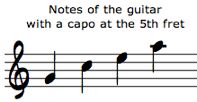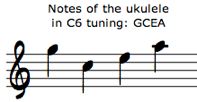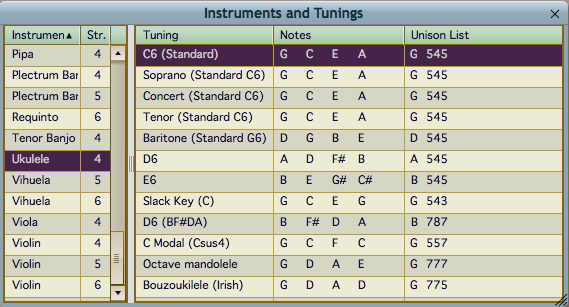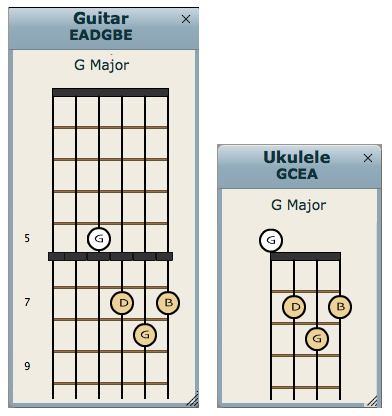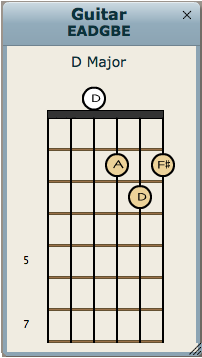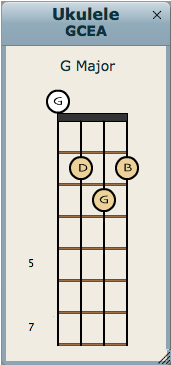Applying your Guitar smarts to Ukulele
|
|||||||||||||||||
Guitar and Ukulele may be more similar than you realize!If you're a guitarist, and you've never held a ukulele, what could you possibly understand about ukulele? Lot's actually. As you'll see, there are striking similarities between guitar and ukulele. Baritone (tuned DGBE) is just like guitarThe four strings of the baritone uke are tuned DGBE ... exactly the same as the four high pitched strings of the guitar (strings number four to one of guitar). Whatever chord and scale vocabulary you possess on guitar applies directly to chords and scales on baritone uke. Simple as that, so we're done with this guitar/ukulele introduction, because Next we'll talk briefly about the uke instrument family: uke tunings, unison lists, and the issue of reentrant tuning. If you really just want to see the other similarities between uke and guitar, jump just a bit further down. Various Sized Ukes: Tenor, Concert and Soprano (tuned GCEA)The three smaller sized ukes (tenor, concert, and soprano ) all share the same GCEA tuning. Though it's a surprise to many, this standard tuning shares virtually a one-to-one relationship with guitar, but there's a simple transpositional difference often obscures the similarity. So here's the the big secret. A standard tuned tenor, concert, or soprano uke has the same pitches as the guitar (strings 1 through 4) IF the guitar is capoed at the 5th fret. In other words, the GCEA tuning is simply pitched a 4th higher than strings 1 through 4 of the standard guitar tuning. We'll go much further in depth on this, but for now it's important to note that the octave of the uke's 4th string may vary. A high G is the common reentrant tuning. And a low G is most commonly found on a tenor uke, but also on concert and soprano. The capoed-guitar connectionOn a guitar capoed at the 5th fret the notes of strings 4 through 1 are as shown here in treble clef notation. The notes are GCEA, eaxactly the same as the ukulele "Low bass" tuning: Here are the open strings of the ukulele when tuned reentrant: The obvious difference is the ukulele's high reentrant G—that G is an octave higher than the 4th string of the guitar capoed at the 5th fret. Reentrant tunings are rather uncommon. The term simply means that the notes are not in straight ascending order. Other instruments with reentrant tunings are: five-string banjo, Cuatro, and Charango. In a sense, even 12-string guitar is reentrant. Because of the uke's reentrant G the actual intervals of tenor C6 uke are: a descending perfect 5th, then the ascending intervals of a major 3rd and a perfect 4th. The G's octave shift is relatively inconsequential as we study chord fingerings. Therefore, we can think of the tenor uke intervals as shown in the guitar tuning: a perfect 4th, a major 3rd, and a perfect 4th. So why not just play guitar?As we seen, with a capo at the 5th fret, the guitar and and uke are practically tuned identically! So, if a capoed guitar and uke can are so similar, why even bother ukulele? Why not just play guitar capo 5? A great deal of the ukulele's charm stems from two factors that guitar cannot reproduce: it's sweet, hollow harp-like tone, and its reentrant high G. These two elements make it an entirely unique instrument. Plus everyone looks friendly when they hold a uke. And let's not forget, it easy to hike or travel with such a small instrument. And it's small size makes it a good fit for kids and people with small hands. So now, with our uke enthusiasm reestablished, let's continue on. Ukulele TuningsWe've already looked at Baritone, and have seen that its standard tuning matches the four high pitched strings of the guitar. There are a number of common alternate tunings, and several shown in the following diagram. You can study them interactively with the Sound Thinking app by clicking on the the Tuning List image below: Unison lists — how they expose the guitar-like similarities!The Sound Thinking app displays a lot of information about each tuning. Above we see the Ukulele selected in the left most column, which is a column of instruments available for exploration. The panel on the right displays three columns: a Tuning column where you can select a particular Tuning by name; the Note column displays the3 names of the tuning; and the rightmost column contains Unison Lists. A unison list is simple, useful, shorthand nomenclature that specifies tuning of a fretted instrument. Most guitarists are familiar with the tuning concept of E 55545 — that's a unison list for guitar's standard tuning. The letter name E specifies the name of the lowest string, then it's 5 half steps (or frets) to the pitch of the next string, and again 5 half steps to the pitch of the next string, and so on. For centuries guitarist have used the 55545 unison list to tune acoustically without the aid of an electronic tuner or a tuner app. To tune this way guitarists:
And now a brief review. A unison list contains a letter followed by some numbers:
Ukulele unison lists
Sorting by Unison List in Sound ThinkingIn Sound Thinking, you can sort instruments by Unison List. Simply click the column's header. Once sorted, we can easily see that the first seven tunings share the same fretboard logic, because they all share the same unison pattern: 5-4-5. It's no surprise that the first four uke tunings have the same unison list— they share the same notes (GCEA). However the letter names for Baritone (Standard G6), D6, and E6, imply a significant difference. In reality, D6 is just a whole step higher than C6 (like putting a capo on the 2nd fret.) And E6 is another whole step higher. And that's the beauty of unison lists—they succinctly describe the open string interval pattern, and illuminate the similarity between tunings. For instance, the first four tunings have a unison list of "G 545".
The unison list for guitar is 55545. So we can see by the 545, that there is a parallel between guitar and ukulele. *Most strings instrument tunings proceed from low to high, but ukuleles are usually strung to a reentrant tuning. . Reentrant means that meaning that one of the strings is tuned higher than the next—and this is nearly universally true on soprano, concert and tenor ukes, where the 4th string is tuned highest. (The unison list logic still gets us the correct letter name, but an octave higher than unison.) Non guitar-like tuningsLower in the tuning list we find:
Each of these tunings has a unique Unison List. So each is beast unto itself, and each is quite unlike guitar ... except C Modal which is rather like DADGAD tuning. Tenor, Concert and Soprano uke (the ubiquitous GCEA tuning)As an experienced guitarist, you possess a lot of applicable knowledge about any uke that's in standard tuning: CGEA—that's the standard tuning for tenor, concert and soprano ukulele. The main difference between these three instruments is their size: tenor is the largest of the three, and soprano the smallest. Another relatively inconsequential difference (from a chordal standpoint) is that some people use a "low G" string (the G is tuned an octave lower.) This practice is most common on tenor ukes, and it removes the reentrant factor, . The Transpositional SecretSo here's the deal is in a nutshell: The standard tuning for uke is the same of the highest four strings of the guitar, except they are raised a perfect 4th in pitch. This little difference throws people off track when first exploring uke chords, because most ukulele chord diagrams for tenor, concert and soprano ukulele look nothing like guitar chords, so it's easy to conclude that uke chords are entirely different than guitar chords. Familiarity comes when you realize that the root names of the chord shapes are different, and that's all. In other words, some uke chords look like guitar chords, but from a guitar player's perspective the chord letter name doesn't match up. For instance a soprano or tenor uke's G chord looks like a guitar D chord, as shown in the upcoming diagram. These matters make ukulele seem like an entirely different instrument or tuning. But it's not. There's just that transposition-shift afoot when playing a soprano or tenor ukulele. Peculiar as they may seem—those ukulele chords are exactly the same as guitar chord fingerings. It's just that the roots (and individual letter names) are not what you'd expect. NOTE: For the rest of this article, when we speak of ukulele, we'll be referring to the popular tenor and soprano uke, which share the same tuning: http://en.wikipedia.org/wiki/Ukulele A useful perspectiveWe'll put this in perspective by applying a handy transpositional twist. Soon you'll grasp the similarities between guitar and ukulele, discern the differences, and you'll be able to leverage your guitar knowledge, which will quickly enable you to explore, play chords and play chord progressions on ukulele. The perfect tools for the task are free, online at TheorecticallyCorrect.com: Chord Transposer and Sound Thinking chord finder. Much more on this soon, and a simple solution to get you going. An interactive comparison: The similarities between Guitar and Tenor, Concert and Soprano.Here's a link that will take you to an instrument comparison page on Sound Thinking: Interactive ukulele/guitar comparison It shows how tenor/concert/soprano uke are the same as a guitar with a capo on the 5th fret. For some, this sort of visual guide clarifies everything in an instqnt. Here, in the image on the left, you can see the guitar's D fingering at the fifth fret (which, due to the effect of the capo is actually a G chord). The image on the right shows the uke's D chords.
Leveraging your guitar knowledgeShortly, I'll introduce you to a tranpositional trick that lets you 'think guitar' while playing ukulele. Though this 'chord chart transposing' technique is a handy shortcut, if you're serious about ukulele, eventually you should memorize the ukulele chord names for the various guitar shapes. This may come naturally in short order; it may take some conscious effort over time. Once you know ukulele chords by name, you'll be able to read ukulele chord charts directly, without transposing them, and you'll be able follow a spoken list of chords. Deferring to styleShortcuts and raw understanding are great, but there is the all-important element of musical style. Learning chords and applying a pocketful of familiar guitar strums to ukulele makes not a lu'au-ready player. There are many stylistic forms in traditional ukulele playing. Traditional players possess a treasure chest of interesting rhythmic strumming patterns, specific chord voicings, cohesive chord progressions, and other nuances worthy of attention. There are delicate regional stylistic nuances. You might feel all pumped up after mastering your first song or two on ukulele. But before you bust in on a smokin' Hawaiian session, quietly join the circle, sit an listen, notice the type of repertoire, observe the elders ... have your ukulele on your lap or in its case, wait until you're invited to play, and enjoy your front row seat. And once invited, tread softly as you go, and don't try to play on every song. Aside from traditional Hawaiian styles, people frequently play ukulele to accompany American swing, jazz music from the 20' through 40's ... and that's really a fun romp. While there's a lot to learn from the pros in this arena, you should feel relatively free to innovate. Oh, and as a newbie in a new land, be sure you pronounce ukulele correctly: oo-koo-LAY-lay. That's why we say 'an ukulele' instead of 'a ukulele.' OK ... my admonition is complete. So let's jump in! But please note that I've really dashed off the following discussion, and it surely needs editing and improving. So proceed with caution. Coming to GripsHere's a side-by-side comparison of a guitar D chord and a Ukulele G chord. Physically they look the same. The colored fingering positions are identical. However the letter names are different:
On the left, we have the guitar D grip. When we apply a guitar 'D grip' to ukulele, the result is an ukulele G chord. (We'll use the term 'grip' throughout this article to refer to a fingering shape, without respect to note names, letter names or key.) The notes in the guitar D diagram are D, F# and A, which is a D chord. When we examine at that same finger shape (or grip) in the ukulele G diagram we see that the notes are G, B, and D, and indeed those are the notes in a G chord. Conversely, from a ukulelist's point of view, when we apply an ukulele 'G grip' to guitar, we get a guitar D chord. Why is this so? Each ukulele string is tuned a perfect 4th higher than guitar (four letter names higher): Strings number: 6th 5th 4th 3rd 2nd 1st --- --- --- --- --- –-- Guitar strings: E A D G B E Tenor Ukulele strings: n/a n/a G C E A
Accordingly, since each string is four letter names higher, each individual chord tone is a 4th higher than on guitar ... and just as the individual chord tones are a 4th higher on uke, when we apply a 'guitar chord grip' to the ukulele, we get a chord that's four letter names higher. Ergo, a guitar D grip produces a G chord on ukulele— just count up four letter names (D E F G) and you've transposed. Add four letter names to any guitar grip and you know the real ukulele name for that grip. But this is hard, and you probably just want to play. So that's enough thinking for now! In order to easily explore the ukulele, we're going employ some tranpositional magic and set aside the music theory. We'll get back to those nitty gritty theoretical details in due course ... and at that time I'll explain some important details, for instance, you'll see why a guitar F grip produced a ukulele Bb (rather than a simple B chord.) You may already understand this ... if not, just let it go for now. OK. Get ready to take the easiest possible route to get you playing uke. Let's transpose some ukulele chord charts. After we do, ukulele chords will make perfect sense. Transposing chords automaticallyHere's the trick. If you transpose the chords of any ukulele chord chart you can play ukulele as if it was a guitar, except of course you have two less strings, and many previously untenable chords are now manageable. Transposer will perform the transpositional calculations for us in a split second. First you need to find or create some text-based ukulele chord charts, run them through Transposer. Then you're on your way, and view the ukulele from a guitarist's perspective. Resources There are lot's of ukulele resources online. Here are a few:
NOTE: This article is unfinished. Sorry, but I've been sidetracked. Feel free to read on, but I don't guarantee coherency or logical flow. This is basically a first draft. *** Transpsoing chords for Ukulele
Transposing ukulele chords manuallySo let's try out some transpositional logic. First, remember than an ukulele is tuned a perfect 4th above guitar. So ...if you play a Dm grip on ukulele, what chord do you get? You get a G minor— G minor is a perfect 4th above D minor. It's easy to count your way to the correct answer. You start at D and simply count four steps up the D major scale: 1,2,3,4: D, E, F#, G. Works every time. When you play a guitar fingering on ukulele, you can figure out the ukulele name by counting up a fourth (five frets) from the guitar chord name. Transposing guitar chords manuallyWhat if you want to play a D chord on ukulele? What guitar grip should you use? Start at D and count backwards four steps down the D scale: 1, 7, 6, 5; D, C#, B, A. The answer is an A grip. When you want to play a ukulele chord, you can determine the required guitar grip by counting down a fourth. If you don't like counting downwards, you can count up a fifth. (We just saw that if we count downwards four steps from a ukulele D we get a guitar A grip. If we count five steps upwards from D, we get the same answer: D, E, F, G, A. I know all that counting seems like a lot of mental effort. You could proceed like this, mentally transposing every chord. But if you don't want to get caught counting on you fingers in public, you could try to establish a lasting mental image. You could make a set of flash cards and test yourself daily. Or like most people, you could patiently rely on extended exposure, and wait a ' ukulele lobe' develops in your brain, where ukulele chords are remapped to the corresponding guitar grips. The third diagram shows the guitar with capo of the fifth fret, and though we think of that shape as D, it actually sounds a G chord.
Guitar and ukulele chordal similarities exist because both instruments have similar, essential identical intervals between strings. The four strings of the ukulele are tuned with the same intervals as strings 4 through 1 of the guitar ( ... although there's a slight reentrant difference, which I'll explain shortly.)
Seeing the ukulele's inner guitarWe've seen how guitar is like ukulele. But to apply your guitar knowledge to uke we need to envision the reverse, and see the guitar in the uke fingerboard. To be continued ...
|
